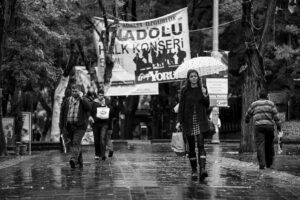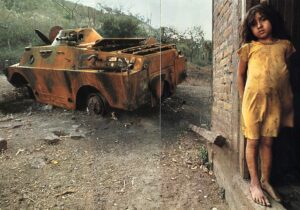At its core, documentary photography captures the truth of life as it unfolds.
It’s a powerful tool that freezes moments of reality, telling stories about the world and its people.
We’ll explore the essence of this art form, delving into its history, purpose, and the impact it has on society.
Stay with us as we uncover the raw power of documentary photography to inform, engage, and inspire.
A Brief History Of Documentary Photography
Documentary photography has its roots deeply embedded in the desire to capture the everyday realities of life.
In the late 19th and early 20th centuries, photographers like Jacob Riis and Lewis Hine used their cameras as tools for social reform.
Riis’s How the Other Half Lives exposed the dire conditions of New York City’s tenements, while Hine’s work highlighted the struggles of child laborers.
Pivotal moments in the evolution of documentary photography are numerous and throughout the years, we’ve seen this genre take on various roles.
Some of the most iconic examples include:
- Dorothea Lange’s Migrant Mother, which encapsulates the despair of the Great Depression,
- Robert Capa’s depictions of the tumult of war through his coverage of the Spanish Civil War and D-Day landings,
- Gordon Parks’s powerful portrayals of the civil rights movement.
The transition from exclusively black and white to color photography marked another turning point for documentary photography.
This shift was notably led by photographers like William Eggleston and his landmark 1976 exhibition at the Museum of Modern Art in New York.
His use of color deeply influenced the aesthetics of documentary storytelling, challenging perceptions of what was suitable for ‘serious’ photography.
As we jump into the nuances of documentary photography, it’s essential to acknowledge the technological advancements that have influenced it.
The invention of smaller, more portable cameras allowed photographers to immerse themselves in their environment, becoming silent observers of unfolding events.
This capacity for candidness has only increased with digital photography and mobile phone cameras, empowering more people to document and share their stories.
With each epoch, documentary photography has been redefined, with modern practitioners pushing its boundaries.
They’re not just capturing moments but also interpreting and presenting complex narratives through their lens.
Our understanding of this genre continues to expand as it adapts to the contemporary landscape, blurring the lines between photojournalism, art, and activism.
The Purpose Of Documentary Photography
Documentary photography serves as a powerful tool that transcends mere visual aesthetics.
It aims to inform, educate, and evoke an emotional response from viewers about real-world issues.
This art form captures more than just images – it captures stories, emotions, and truths that might otherwise go unnoticed.
These photographs act as historical documents that can challenge society’s perceptions, inspire change, and even influence policy.
They give us insight into:
- The living conditions in different periods,
- Social injustices,
- War and its impact on civilians,
- Cultural celebrations and daily life.
By bearing witness to moments big and small, documentary photographers create a visual dialogue between the subject and the viewer.
These images often spark discussions that are crucial for progress and understanding.
Their authenticity is vital as they provide a level of trust and connection that written accounts alone cannot.
The integrity of documentary photography rests on its commitment to reality.
While it can explore subjective truths, the genre is rooted in a direct relationship between the photographer, the subject, and the viewer.
Our responsibility is to ensure that the narratives we share through our lenses are genuine, unaltered, and respectful to those we document.
Technological advancements have broadened the capabilities of documentary photography.
Today, we can share images with a global audience almost instantaneously.
This instant access empowers photographers to spread awareness and prompt action with a speed that was once unimaginable.
It’s a tool that brings to light the various dimensions of human existence and helps us better understand the world we live in.
Techniques And Approaches In Documentary Photography
In the realm of documentary photography, various techniques and approaches play vital roles in conveying a story’s essence.
We often see photographers immersing themselves in their subjects’ environments to obtain an insider perspective.
This fly-on-the-wall approach ensures that the narrative is as authentic as the raw moments captured.
Another crucial technique is the deliberate choice of framing and composition – guiding the viewer’s eye to the heart of the story.
Capturing the decisive moment is more than just a matter of luck.
It requires a keen sense of observation and anticipation.
Great documentary photographers like Henri Cartier-Bresson exemplified this with their ability to capture the essence of an event in a single frame.
Timing can elevate a photograph from a simple image to a powerful statement.
Understanding the use of light and shadow is also essential:
- Light often symbolizes hope or clarity,
- Shadows can introduce elements of mystery or foreboding.
These elements work together to create a multi-layered narrative that goes beyond the surface, delving into the deeper truths of the subject matter.
Meanwhile, some photographers employ a participatory approach, where the subject is aware of the camera’s presence and may even collaborate with the photographer.
This can lead to a different kind of truth – one that’s co-created by the photographer and their subject.
The choice between black and white or color photography can greatly influence the mood and reception of the work.
Black and white can evoke timelessness and focus strongly on composition, whereas color adds a vivid dimension that can be used to attract attention or highlight contrasts within the narrative.
In our exploration of the power of documentary photography, we must also consider the evolving digital tools at our disposal.
Digital enhancements and social media distribution have extended the reach and impact of the stories we tell.
Yet, we must stay vigilant to maintain the authenticity that stands at the heart of documentary photography.
Photographers play an educator’s role – they are our eyes in corners of the world we might never see otherwise.
By employing these various techniques and approaches, they bring to us not just images, but stories, emotions, and truths that might otherwise remain untold.
Impact And Influence Of Documentary Photography
Documentary photography has often served as a catalyst for social change.
It throws an uncompromising lens on issues that might otherwise remain invisible.
Through the raw power of visual storytelling, photographers like Dorothea Lange with Migrant Mother have illuminated the human condition, swaying public opinion and policy.
Historically, iconic images have burned themselves into the collective consciousness, shaping our understanding of events and eras.
The Vietnam War’s narrative was indelibly altered by images such as Napalm Girl by Nick Ut.
These visual accounts can bypass language barriers and political divides, delivering an emotional punch that resonates on a universal level.
We recognize several key ways documentary photography has influenced society –
- Sparking Dialogue: Captivating images often become the subject of public conversation, setting the stage for dialogues around critical social issues.
- Advocating Change: By highlighting injustices, documentary photography can advocate for policy changes and humanitarian efforts.
- Preserving History: These photographs serve as historical documents, capturing moments that define eras and movements.
Educational platforms and museums have embraced the medium, using exhibitions to inform and inspire.
Works by photographers like Sebastião Salgado in Genesis or James Nachtwey’s coverage of modern conflicts, impart lessons that transcend the classroom, landing with an impact that can spur audiences into action.
The digital era has amplified the reach of documentary photographers, allowing images to circulate globally within seconds.
Online platforms and social media have democratized access, enabling a broader spectrum of stories and storytellers to emerge.
As we navigate this landscape, we’re vigilant about the authenticity and ethics of the visual narratives we encounter and share.
The Ethical Considerations In Documentary Photography
As we jump into the realm of documentary photography, it’s vital to address the ethical responsibilities that come with such visual storytelling.
Documentary photographers often find themselves in situations where the power dynamics between the subject and the photographer could be questioned.
Informed Consent is a core principle – photographers must ensure subjects are aware of how their images will be used.
This becomes even more complex in sensitive situations involving vulnerable individuals.
As experts in this field, we’ve seen the ramifications when consent isn’t properly obtained.
The essence of telling True Stories should remain untainted by any personal biases that may distort the truth.
Yet, we understand the fine line that exists between capturing a moment honestly and influencing the scene.
- Objectivity and truthfulness,
- The photographer’s impact on the scene,
- Editing with integrity.
Seeking to minimize harm, documentary photographers should also reflect on the potential consequences of their work.
- Could publishing certain images lead to harm or stigma for the subjects?
- Are there situations where the photographer should step in to assist rather than merely document?
Considering these factors is not about limiting creativity.
It’s about respecting the subjects and understanding our role within the broader societal impact.
Finally, respecting Privacy and Dignity is
Just because a moment can be captured doesn’t always mean it should be.
Whether working in a disaster zone or a close-knit community, recognizing the right to privacy and upholding the dignity of subjects is crucial.
We must navigate these waters with care, ensuring that our pursuit of compelling storytelling does not overshadow these fundamental ethics.
What Is Documentary Photography – Wrap Up
We’ve explored the profound influence of documentary photography, recognizing its power to inform and instigate change.
It’s our responsibility to approach these visual stories with a critical eye, understanding the weight they carry in shaping public perception.
As we navigate the vast landscape of images that chronicle our world’s history and current events, let’s honor the principles of ethics and integrity.
By doing so, we ensure that the truth prevails and the dignity of those captured in these snapshots is upheld.
Let’s continue to engage with documentary photography not just as passive viewers but as active participants in the ongoing dialogue about our society and its many stories.
Frequently Asked Questions
What Is The Role Of Documentary Photography In Society?
Documentary photography plays a critical role in society by bringing attention to important issues and often serving as a catalyst for social change.
Through powerful imagery, it can shape public perception and understanding of historical events and contemporary concerns.
How Do Iconic Images Impact Our Understanding Of Events?
Iconic images capture moments that define and symbolize historical events or eras, impacting society’s collective memory and understanding.
They often become reference points that articulate the essence of particular issues or times.
What Is The Effect Of The Digital Era On Documentary Photography?
The digital era has greatly amplified the reach and influence of documentary photographers.
It allows for instant dissemination of images and opens up avenues for discussions and movements, though it also raises concerns regarding the authenticity and responsible sharing of visual narratives.
Why Are Ethical Considerations Important In Documentary Photography?
Ethical considerations in documentary photography ensure the protection and dignity of subjects, maintain the objectivity and truthfulness of the narrative, and minimize harm.
Adhering to these principles supports an ethical framework for the practice, upholding the integrity of the photographer and the subject alike.
How Does Informed Consent Relate To Documentary Photography?
Informed consent in documentary photography involves seeking permission from the subjects to be photographed and ensuring they are aware of how the images will be used.
It is a fundamental aspect of ethical practice, safeguarding the subjects’ autonomy and rights.






